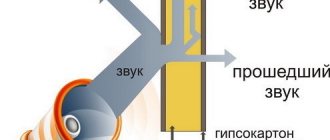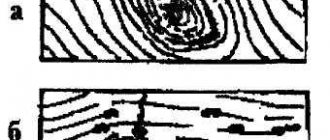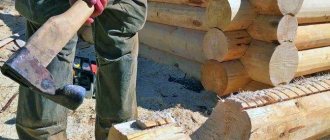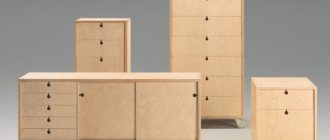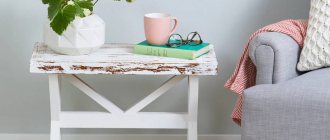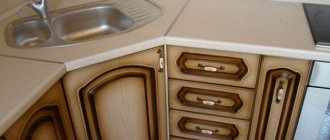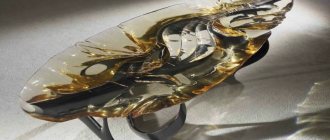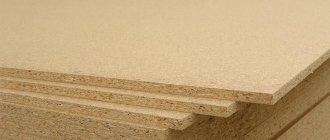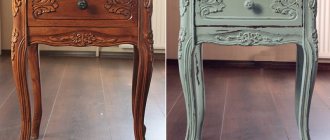Modern furniture manufacturers offer a variety of options for making custom-made furniture. And one of the issues that you need to decide is the choice of material. Today we will compare the advantages and disadvantages of the most popular furniture materials - Chipboard, MDF and solid wood.
Furniture made from chipboard and MDF, in comparison with furniture made from solid wood, has a seemingly undeniable advantage - a more affordable price. But what exactly will this mean once you start using this furniture?
Chipboard: advantages and disadvantages
So, chipboard is a material that is obtained by mixing and pressing dried industrial chips and resins.
- Chipboard has two significant disadvantages:
- does not hold screws and nails well;
- environmental unsafety.
As a result, it turns out that furniture made of chipboard, if necessary, will be quite difficult for you to repair: once a screw has fallen out, you will have to screw it in again and again. And by definition, there is a chance that it will fall out - chipboard, in principle, does not “accept” foreign bodies well.
The bigger issue is your family's health. The resins that are used in the production of chipboards tend to emit formaldehyde, which is harmful to your health. For this reason, a very important parameter when choosing a material is the permissible concentration of harmful substances per specific volume.
Unfortunately, cheap, low-grade slabs that do not meet established standards are not so rare these days. This means that there is a possibility that, having saved on buying furniture for the living room or bedroom, you will have to spend a significantly larger amount on restoring your health. Even the concentration of formaldehyde that may be present in a room with low-quality furniture can cause headaches and loss of strength. It is not in vain that slabs of the E1 class (quite popular in Russia) are no longer produced abroad, but only slabs of the “Super E” class are produced. By the way, another important point: in the Russian Federation, E2 class slabs are prohibited from being used for the production of children's furniture, which, alas, does not at all mean that such furniture is not available for sale.
Conclusion:
Chipboard is unreliable and dangerous.
comparison table
Comparison chart of MDF and plywood
| MDF | plywood | |
(139 ratings) |
(188 ratings) | |
| tripartite | Wood fibers obtained by breaking down hardwood and softwood are combined using wax and resin and heat-pressed. | Thin sheets of veneer glued together |
| Structure | Uniform, smooth and free of knots. | An odd number of layers with grains from adjacent layers at right angles to each other. Facial veneers are higher quality than basic veneers. |
| Security threat | Use of urea-formaldehyde and phenol-formaldehyde resins, which are carcinogenic in very high concentrations | Use of urea-formaldehyde and phenol-formaldehyde resins, which are carcinogenic in very high concentrations |
| Benefits | Cabinet Construction, Crafts, Moldings/Finishing, Shelving (Sliding Bookshelves) | Roofs, walls, bases, boxes, bags, sports equipment, music equipment, gaming equipment, high quality loudspeakers |
| Description | • Has a smooth, even surface. •Easy to process, paint or stain. • Available in water and fire resistant form. • Can be machined. | • Very strong board constructed from layers of veneers or layers that are glued with grains 900 degrees to each other • Available in internal and external grades • Very strong waterproof plywood (WBP) that can be used in extreme conditions. |
Pros and cons of MDF
MDF, or medium density fiberboard, is a material that is made by dry pressing wood chips with carbide resins modified with melamine. The cost of MDF is higher than the cost of chipboard. But the material is worth it: first of all, MDF does not emit substances hazardous to health . And the strength of MDF is on average two times higher than the strength of chipboard. This material has another important advantage - it makes possible a wide variety of furniture designs, since it can imitate natural wood, metal, and glass.
Does MDF have any disadvantages?
Yes. This is a highly flammable material, for which the potential risk of ignition is not only contact with an open flame, but also contact with quickly heated surfaces, and even faulty wiring laid next to MDF furniture. MDF boards are often characterized by low resistance to moisture. However, these shortcomings can be eliminated through special production technologies that make the material waterproof, fireproof and bioresistant. But you understand that “special production technology” are words that also mean a higher price. And therefore, the comparison of prices for furniture made of MDF and solid wood becomes not so bright.
Another disadvantage of MDF is its vulnerability to mechanical stress. Of course, you won't break MDF furniture with your finger, but is it possible to rule out stronger impacts with absolute certainty?
Conclusion:
not always reliable, but safe.
Comparative characteristics of plywood and other board materials
What board materials do manufacturers offer?
Plywood
For production, wood veneer sheets with a thickness of 0.3 to 4 mm are used. The sheets are tightly glued to each other using glue of varying degrees of moisture resistance. There are FC plywood (with an average degree of resistance to moisture) and FSF (with increased performance). Can be laminated in various colors with wood grain imitation.
OSB
Wood chips are removed with special equipment along the grain to preserve strength characteristics. It is bound with a composition of resins, boric acid, and wax, and then pressed into slabs. Certain types (OSB-3, OSB-4) are applicable in high humidity conditions for the construction of external structures.
Chipboard
They are made by hot pressing small particles of wood with various resins. They can have a regular or fine-textured surface and increased moisture resistance. For indoor use. For decorative purposes, laminated and veneered chipboard is made.
Fiberboard
Production involves pressing and subsequent drying of wood waste with or without the addition of resins. They differ in hardness, density, and refinement of the front surface. Due to its low thermal conductivity, fiberboard is often used to insulate roofs and floors. For interior work and furniture production, surface lamination is carried out.
MDF
The wood particles are compressed under high pressure to achieve a high density comparable to boards. The binding material is the natural substance lignin contained in the wood itself. It is most often used for the production of furniture, which can be used even in damp rooms.
What characteristics to consider when choosing?
Strength
If we compare the strength characteristics of the listed materials, then MDF will be the leader. It can be broken under pressure in excess of 20-22 MPa, which not every tree can withstand. Chipboard and fibreboard have high fracture strength due to their homogeneous structure. Plywood and OSB have generally the same strength, but OSB has a higher shear strength.
Scope of application
The most versatile is OSB. Types 1 and 2 slabs are used to produce furniture, build internal partitions, podiums, etc. Due to their increased characteristics, slabs of types 3 and 4 are used for the construction of external structures and cladding of facades.
Other types of board materials are used for internal purposes (except for FSF plywood - it can serve, for example, as formwork). Chipboard and fibreboard are used for the manufacture of furniture, partitions, decorative elements, floors, and internal roof lining. MDF can most often be found as a material for furniture facades, wall panels, interior doors for any room.
Weight
In order to clearly demonstrate which material is lighter, we suggest comparing the average weight of the most popular slabs:
- OSB-3 2500x1250x8mm (0.25 cubic meters) weighs 15.56 kg, and a cubic meter of material weighs 62.24 kg;
- FK plywood 1525x1525x 10 mm (0.23 cubic meters) weighs 14.74 kg, and a cubic meter weighs 64.08 kg;
- Chipboard 2500x1850x16 mm (0.74 cubic meters) weighs 48.84 kg, and a cubic meter - 66 kg;
- Waterproof plywood FSF 2440x1220x 12 mm (0.357 cubic meters) weighs 25.8 kg, and a cubic meter - 72.27 kg;
- MDF 2800x2070x16 mm (0.927 cubic meters) weighs 72.36 kg, and a cubic meter weighs 78 kg.
- Fiberboard 2745x1700x3.2 mm (0.149 cubic meters) weighs 12 kg, and a cubic meter weighs 80.53 kg.
Ease of processing
The surface of plywood is easy to sand, so the products just need to be primed and varnished - you will get a smooth surface with a natural wood pattern. Chipboard is also subjected to high-quality sanding. All types of board materials can be laminated.
MDF lends itself to the finest processing, is glued and painted, and covered with PVC films of any shade. Chipboard and fiberboard are easy to mill and drill. Plywood and OSB are most suitable for cutting. Laminated materials should only be sawed using professional equipment.
All of these slab materials are attached with glue, painted with any wood paints, and treated with varnishes. MDF, fiberboard and chipboard are not the best option for screwing in screws, and they do not lend themselves well to nails. It is better to use plywood for nailing.
Moisture resistance
The best moisture resistance indicators are for OSB types 3 and 4. It can be kept in water for a day, and the swelling coefficient will not exceed 10%. During the same time, moisture-resistant chipboard will swell by 15%, but ordinary chipboard will swell by 33%. Among materials for interior work, MDF stands out from this point of view.
Moisture-resistant FSF plywood suggests the possibility of use in conditions with atmospheric humidity up to 85%. But for chipboard and fibreboard, moisture resistance increases solely through lamination.
Environmental friendliness
Chipboard without lamination, painting or other treatment is not recommended for use in residential premises, since formaldehyde adhesives emit substances that can negatively affect human health. Laminated chipboard does not cause any harm.
MDF has the best environmental performance due to pressing technology. Plywood also has high environmental performance, as it is made directly from wood. OSB boards are attractive because fungus does not form on them and they are not susceptible to rotting.v
Price
The price of materials plays an important role, but you need to start from the specific purposes of the purchase. For example, to level floors, it is cheaper to use chipboard and fiberboard. OSB is a fairly inexpensive material, especially since it is universal, and there are practically no alternatives for use in outdoor work. The most expensive purchase is MDF, but the price of these boards corresponds to the possibilities of their processing, and they are extremely wide.
Source: www.allfanera.ru
Solid wood: pros and cons
Finally, a tree. Of course, you have thought more than once that this is probably the most capricious material for furniture precisely because of its nature. Yes, in some ways this is true. For example, oak, even after it has been transformed from wood into furniture, remains an aristocrat. Oak furniture requires special treatment: for example, you cannot place a hot mug on it. And if it is also waxed furniture, and you have a habit of smoking, then you will see on the surface of your furniture what is happening inside your body. The tree will continue to breathe, which means it will absorb smoke and odors. Yes, solid wood furniture will require your attention and respect. But what will she give you in return?
- Eat four advantages of natural furniture
- environmental friendliness . Cabinet furniture made from solid wood will in no way harm your health: it simply does not contain toxic impurities.
- practicality _ Yes, we started our conversation about wood as a capricious material. But the fact is that precisely because of its natural properties, solid wood is more resistant to both moisture and rot than chipboard and MDF. In addition, the modern market offers different coatings for furniture made from natural solid wood, which means that the degree of protection of the solid wood can be very high. Just choose furniture made of natural wood, coated with polyurethane varnish - and you can forget about the problem of a hot mug!
- aesthetics . Remember when we said that the surface of MDF can imitate wood? But this is still nothing more than an imitation. And the only thing more beautiful than just furniture made of natural wood is very good furniture made of natural wood.
- energy of wood . We all know that trees are able to share the pure energy of nature with us. That oak is a tree that helps you gain clarity of thought and strength, and beech charges you with invigorating energy. But have you heard this about chipboard? Hardly. But the fact that formaldehyde, which is emitted by chipboards, can cause depression is a scientifically proven fact.
, in which neither chipboard furniture nor MDF furniture can yet compare with it:
So it turns out that investing in furniture made from natural wood is not just a practical and environmentally friendly choice for a person who appreciates the graceful simplicity of nature. It is also an investment in the health and harmony of your family.
Conclusion:
reliable and useful.
What is plywood?
Plywood is made from sawmill. Thin layers are removed from wooden logs by rotating them along their horizontal axis. The veneer sheets produced by this method are cut to the desired dimensions, dried, straightened, glued, and then baked in a press at 140 °C (284 °F) and 1.9 MPa (280 psi) to form the plywood panel. Depending on the grade of plywood, it may or may not be smooth and useful for a visually pleasing wooden interior. Some types of plywood can be painted and look good for kitchen cabinetry.
Watch the video below to learn more about the differences between plywood, MDF, high-density fiberboard (HDF), chipboard and chipboard.
Features of plywood
Plywood is a wood building material made from sheets of peel-cut veneer glued together. Almost everyone can afford to buy plywood in Kyiv using this link https://www.plittorgservis.com.ua/fanera, because the price of the material is several times lower than the cost of wood. At the same time, plywood has excellent performance characteristics:
can be easily machined in various ways;
have high strength;
resistant to deformation;
compatible with other materials;
has a beautiful surface structure.
On the modern market, plywood is presented in a variety of types. You can buy material made from birch or coniferous wood, moisture-resistant or lined with film; sanded on both sides or without sanding at all.
"PRICE QUALITY"
Currently, very popular construction, finishing, and also materials used in the manufacture of furniture are chipboard, plywood, and MDF. And it is difficult to find a person who has never heard of the existence of these materials. However, if we summarize the priority of choosing a base for artificial stone products among the many requests to us, it can be noted that there is no unanimous opinion or agreement yet. Of course, your choice has been and will be one of the important criteria for us when placing an order; our task is to help you choose materials worthy of attention at affordable prices.
This article will describe the main criteria of these materials, as well as how chipboard, plywood and MDF are similar, and how they differ from each other.
Use in construction
Plywood is used in house construction.
MDF is used for doors and interior panels in construction, where moisture is not likely to damage it, but was developed exclusively for furniture. As such, it is mainly used for indoor applications.
Plywood is used for doors, exterior stairs, exterior cladding, flooring, framing, interior railings and balustrades, interior stairs, interior paneling, shear walls, wood millwork, and wood frame portals in construction. Plywood bends easily with the grain, so it is often used to create curved surfaces. For example, the top smooth surface is sometimes used to create the curved slopes of a skateboard.
Source: ru.betweenmates.com
How to choose the right chipboard?
Today there are a considerable number of chipboards for various purposes. Their differences lie in thickness, composition, wear resistance, and density. Such features are associated with use in different areas of plate production. There is a stereotype about the density of the slab. It is believed that the denser it is, the better. But it is not so. The advantage of these boards is the low-cost raw materials (low-grade wood). This includes “thin gauges”, slabs, slats. The main thing is that these materials meet the following standards.
- Chip fractions should not be small.
- The cross-section of the chips should be square and petal-shaped. If these requirements are violated, the physical and chemical properties of the finished slab will deteriorate (bending and resistance will suffer).
Laminated chipboard has a wide range of colors, which is widely used in the production of cabinet furniture.
Consumers often ask questions: what kind of material is this for a bed - MDF? What is the difference between MDF and laminated chipboard for furniture? Let's consider these nuances in more detail.
The film is paper impregnated with melamine resins, which is why you can often find the term “melamine board”.
Advantages of chipboard:
- low price;
- does not dry out, does not flake, does not mold;
- thanks to chemical additives, bugs do not live in the stove;
- service life more than 10 years.
Pros of MDF:
- reasonable price for consumers with average incomes;
- strength;
- moisture resistance;
- includes all of the above advantages of chipboard.
Laminated chipboard can be washed and cleaned - it is moisture resistant.
The choice of material depends on what you plan to make. Laminated chipboard can be used in the manufacture of furniture intended for offices, homes, shops, and supermarkets. MDF is better to choose for children's furniture.
He is also not afraid of high temperatures.
The production of fibreboards allows us to produce products at affordable prices for various interiors. Thanks to MDF and laminated chipboard furniture, every home will be filled with coziness, warmth and comfort.
Its advantage, in addition to all of the above, is its excellent ability to imitate various textures, most often imitation of wood texture.
Pay attention to the standards for formaldehyde content in cabinet furniture.
VIDEO: Furniture made of wood or furniture made of chipboard.
Structure of laminated chipboard
It features a huge range of shades and patterns that imitate the texture of natural wood, stone, marble chips or abstract patterns. The result of the cladding process is laminated chipboard.
The coating has the same properties as regular plastic: it better withstands water, detergents, damage, and temperature changes. Widely used in furniture production, both cases and facades.
Laminating
- a decorative coating made of paper impregnated with paraffin or resin compounds. This film is less resistant to moisture, elevated temperatures, and mechanical damage. It is used in the manufacture of inexpensive furniture and large wall panels.
Veneering
– facing with a thin layer of veneer (cut of valuable wood). Doors and components, furniture facades, and sometimes even wall and ceiling panels are made from this material.
Painting with any types of varnishes and paints. This means of refining the slab is considered the most economical and “homey”.
MDF furniture - what is it?
MDF is an improved technology for the production of chipboard materials. The board consists of small compressed fractions of sawdust. Thanks to this method of fastening, the material is highly durable, homogeneous and harmless to health. Thanks to these indicators, it can be used for the production of any furniture, including for a children's room. Its cost is slightly higher.
The main difference between laminated chipboard and chipboard is the coating. It is pressed into the structure of the slab, making it more durable and moisture resistant.
The main advantages are the high strength of the slabs, uniformity, ease of processing, moisture resistance, anti-deformation abilities, a wide range and beautiful design.
MDF is a fairly dense material - this makes it indispensable in the production of furniture that requires turning graceful lines, roundness, etc.
Cons: high price, boards are susceptible to mechanical damage and shock, and are easily flammable.
MDF is an environmentally friendly material and has no restrictions on its use.
"PRICE QUALITY"
Currently, very popular construction, finishing, and also materials used in the manufacture of furniture are chipboard, plywood, and MDF. And it is difficult to find a person who has never heard of the existence of these materials. However, if we summarize the priority of choosing a base for artificial stone products among the many requests to us, it can be noted that there is no unanimous opinion or agreement yet. Of course, your choice has been and will be one of the important criteria for us when placing an order; our task is to help you choose materials worthy of attention at affordable prices.
This article will describe the main criteria of these materials, as well as how chipboard, plywood and MDF are similar, and how they differ from each other.
Cost of Plywood vs MDF
MDF is generally cheaper than plywood, but a lot depends on the grade of plywood and the wood species used. Higher quality plywood is more expensive because it is more aesthetically pleasing, often with natural hardwood or softwood grains; lower ratings are used in construction work where they will not be visible (for example, for a subfloor). Both wood products are also rated based on thickness.
A 1/4" sheet of Bendy MDF (24" x 48") is about $22 on Amazon, while a grade B-BB plywood sheet (1/4" thick, 24" x 30") is $10 on Amazon.
How does MDF differ from chipboard in appearance?
Many believe that these two building materials are similar not only in production, but also in appearance. This is wrong.
The fine wood fraction has the following characteristics:
- the surface of the slab is even and smooth;
When studying the section, one can note the homogeneity and fine-grained structure of the material.
Chipboard also has distinct characteristics:
- the surface is uneven, slightly rough;
at the cut site you can see pieces of shavings and looseness of the material.
Fiberboard (fibreboard)
Familiar to all those who have at least once moved cabinets away from the walls. This is hardboard familiar to all of us. The back walls of most cabinets, the bottoms of drawers, these sheets that are rough to the touch are fiberboard (the most expensive furniture uses plywood instead of fiberboard, but its performance properties are not much better). Like MDF, fiberboard is made from compressed wood dust - but in the case of fiberboard, the wood particles are steamed, and the board is made by wet pressing. That is why the “wrong side” of fiberboard texture resembles the surface of cottage cheese with a “mesh”, like wet gauze. And that’s why fiberboard slabs are never thick: technology doesn’t allow it. Usually one side of the fiberboard remains like this, and the other is covered with film (laminated or laminated).
Plus: low price with high durability.
Cons: small range of uses. Of course, you can’t make a complete set of furniture from fiberboard, but at the same time, it’s almost impossible to replace fiberboard “in your own field.”
